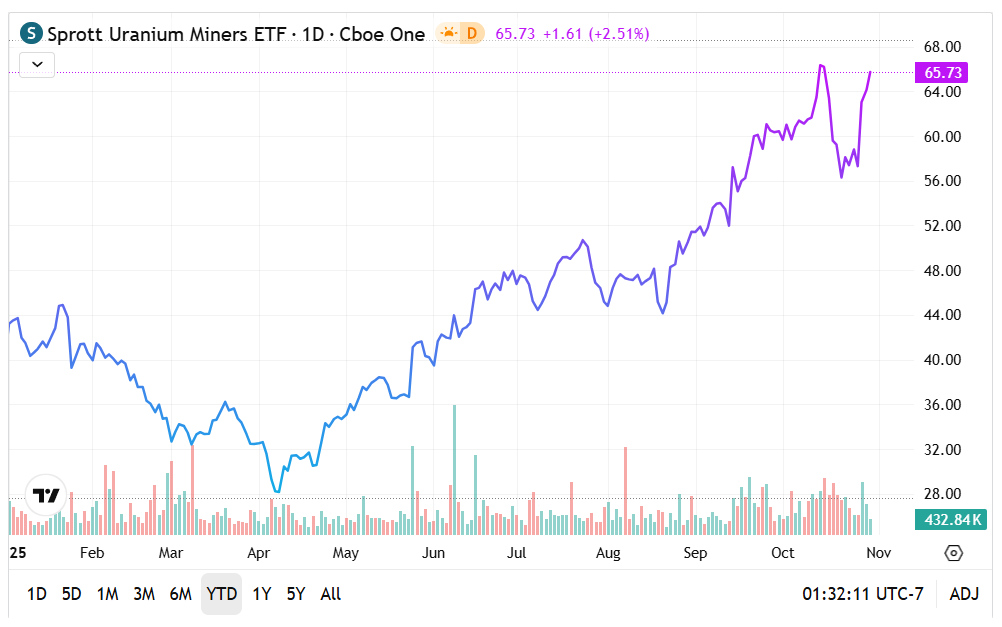
Although the rise of artificial intelligence and the subsequent demand surge have created robust market demand for affiliated infrastructures, global nuclear energy leaders expressed serious concerns about future supply chains and resource management. During the 50th Symposium hosted by the World Nuclear Association (WNA), experts in the field warned that electricity consumption by data centers next year will be roughly equivalent to that used by the nation of Japan.
Subsequently, the underlying arithmetic points to a tripling of capacity by 2050 as a bare-minimum requirement. However, a looming uranium shortage threatens to derail the nuclear energy ascension. It really comes down to a simple math equation: as demand for nuclear fuel rises sharply, the inventory of the critical resource from existing mines will likely incur a net deficit.
Indeed, output from today's deposits is expected to halve between 2030 and 2040 amid broader resource depletion. This dynamic imposes a "significant gap" in the global supply chain because demand for commodities tied to power generation is only accelerating. As such, the WNA has urged miners to boost exploration and investment initiatives. Otherwise, the nuclear industry may have tremendous difficulty supplying worldwide energy needs.
What's adding to the dilemma is the structural constraint of the uranium sector. Unfortunately, uranium mining is uniquely challenging to scale, with projects taking 10 to 20 years to transition from discovery to production. Furthermore, costs can be high and potentially onerous.
If that wasn't challenging enough, there's also the matter that multiple countries and regions are competing for the relatively rare commodity. In September, for example, Sweden announced a draft law to lift its ban on uranium mining, a reversal of a 2018 decision. Fundamentally, the lesson here is that Europe is trying to decrease its reliance on imports for its energy and critical minerals.
Still, the news points to the uncomfortable reality that the region is broadly struggling with energy security. With competition poised to accelerate in the future, many are turning to uranium as an investment opportunity.
The Sprott ETF: While the calculus for key energy resources arguably points to a bullish conclusion, investing in uranium presents many difficulties for retail market participants. Some sector funds are only advertised as uranium vehicles but may contain indirect exposure, such as utility companies. Others might not hold the asset directly, leading to synthetic exposure that may not cleanly align with the uranium market. Finally, some of the top-tier uranium players fall well outside the North American purview.
For investors who are interested in uranium but desire as few ancillary elements as possible, the Sprott Uranium Miners ETF (NYSE:URNM) presents a viable alternative. Known worldwide for its expertise in the precious metals and resource markets, Sprott Inc. (NYSE:SII) delivers pure-play exposure to nuclear energy.
Fundamentally, what distinguishes the URNM ETF is its direct exposure to uranium miners; that means no utilities nor diversified energy giants. Instead, the focus is on miners, explorers and developers. A second key factor to consider is that URNM holds the actual asset through a closed-end trust, which is unusual for an equity ETF. Third, the fund covers a global base, with exposure tied to resource-rich nations like Australia, Canada and Kazakhstan.
Although the URNM ETF may be attractive to certain investors, several risks exist that must be considered. Primarily, the direct exposure to uranium means that the magnitude of volatility for this fund will likely be more robust than standard funds tracking benchmark indices like the S&P 500 or the Nasdaq Composite. In addition, as a non-diversified fund, URNM should be considered a high-torque vehicle. That means the upside can be intense, but downturns may also be severe.
Lastly, because uranium features technical challenges such as relatively low liquidity and commodity price instability, the URNM ETF should almost be treated like a leveraged fund. While investors may be able to enjoy high reward potential, the risks are likewise enormous.
The URNM ETF: Since the start of the year, the URNM ETF has gained 63%. In the trailing half-year period, the fund shot up almost 90%.
- After succumbing to brief volatility, URNM's price action shot firmly above its 20-day exponential moving average.
- Volume levels in September and October have been noticeably elevated compared to levels seen in the summer this year.
- While the price action stands comfortably above the 50 and 200 DMAs, peak accumulative volume has declined. Ideally, this metric should rise in conjunction with the price.

Featured image by Markus Distelrath on Pixabay.







